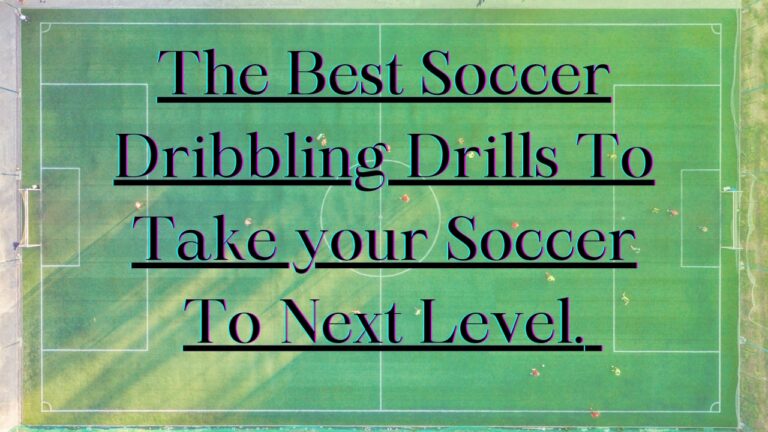Passing is the foundation of soccer success. Having a full repertoire of passing techniques provides versatility in building attacks, maintaining possession, and unlocking defenses. Here are step-by-step instructions for 15 soccer passing drills to perfect your technique.
1. Inside of the Foot Pass
The inside of the foot pass is the most common ground pass in soccer.
– Approach the ball at a slight angle rather than straight on. Keep your passing shoulder in line with your target.
– Strike the center of the ball with the instep of your foot. Keep your toe pointed up and your ankle locked for stability.
– Follow through straight towards your intended target. Extending your leg fully powers accuracy.
– Plant your non-kicking foot firmly beside the ball, turning your hips for momentum. This balances your body for optimal technique.
Tip: Master passing off both feet to avoid being one-dimensional.
2. Laces Pass
Lace passes maximize power for long balls and shots.
– Approach the ball from a small angle and lean your body over the ball, keeping your weight forward.
– Make solid contact through the middle of the ball with your laces using a locked ankle.
– Follow through straight toward your target with a long fluid stride for full power transfer.
– Keep your non-kicking planted firmly in the ground near the ball to prevent falling away.
Caution: Injuries can result from improper technique and poor ankle stability.
3. Outside of the Foot
The outside-of-the-foot technique creates bending passes around defenders.
– Approach the ball from a wide angle.
– Contact the ball with the little toe edge of your foot, keeping that side facing your target.
– Wrap your foot slightly around the ball for clean contact, and bend.
– Follow through towards your target by bringing the kicking leg across your body.
Tip: Practice from both angles to bend passes left or right.
4. Bent Passes
Bent passes curve around defenders using the outside foot technique:
– Approach from a wide angle and lean over the ball, putting your body weight on the standing leg.
– Wrap your kicking foot around the ball, striking with your little toe.
– Follow through towards the far post with your leg crossing your body.
– Increase power to sharpen the bend on longer passes.
Caution: Start with less bend to avoid overhitting passes out of play.
5. Driven Passes
Driven passes travel fast and low, ideal for breaking defensive lines.
– Approach the ball slightly off-center. Plant your non-kicking foot alongside the ball, pointing at the target.
– Drive down through the middle of the ball, contacting it with your laces while keeping your ankle firm.
– Transfer weight from the back hip through to the front hip for power. Follow through straight towards the target.
– Keep your upper body over the ball for balance and control. Make contact below the ball’s equator.
Tip: Accuracy comes with practice. Start slowly focusing on technique.
6. Lofted Passes
Lofted passes sail over defenders and into space for teammates to run onto.
– Approach underneath the ball, leaning back slightly.
– Contact the lower half of the ball with your laces using an upward strike.
– Follow through high towards your target area.
– Generate loft by striking upwards through the ball. Adjust power for distance.
Caution: Avoid overhitting lofted passes out of play.
Related Post : The Complete Guide to the Different Types of Passing in Soccer
7. Through Pass
The through pass splits defenders for an attacking teammate to run onto.
– Assess the positioning of defenders and teammates to identify gaps to play the ball into.
– Approach the ball from an angle and plant your non-kicking foot pointed towards the opening space.
– Strike the ball with your instep, driving through the center of the ball.
– Follow through straight towards the intended space, leading your teammate’s run.
– Use perfectly weighted pace and accuracy for your teammate to run onto.
Tip: Master both ground and lofted through passes.
8. Cross-Field Switch
Cross-field switches transition play from one side to the other.
– Scan the full field before receiving to pick your target wide player.
– Approach the ball on a slight diagonal, getting your hips and shoulders open towards the target.
– Strike through the center of the ball with your laces for distance.
– Follow through fully towards the opposite flank. Use proper weight and trajectory.
– Lean forward with your opposite arm out for balance and alignment.
Caution: Avoid switching play into crowded areas to maintain possession.
9. Crosses
Crosses are passed from the flank into the penalty area for a finish on goal.
– Identify your intended target striker before crossing. Coordinate runs and timing.
– Wrap your non-kicking foot around the ball, opening your hips upfield.
– Whip your kicking leg through the lower half of the ball with power.
– Follow through strongly towards the striker’s anticipated near-post run.
– Drive off the non-kicking foot, using your arms for balance.
Tip: Variety keeps defenders guessing – mix up lofted and driven crosses.
10. Cutbacks
Cutbacks are dangerous passes from the goal line across the penalty area.
– Get to the end line and assess options before cutting the pass back. Be patient.
– Shape your body sideways with your back foot planted outside the ball, hips open towards the area.
– Strike through the middle of the ball with your instep.
– Follow through directly across the box, keeping the pass low for control.
– Use checking runs and communication for teammates to attack cutbacks.
Caution: Avoid forcing low-percentage cutbacks when better options are available.
11. Headers
Heading lofted passes helps maintain possession and relieves pressure.
– Read the flight of the incoming ball and move to get your head over it.
– Strike the ball solidly in the center of your forehead. Time the contact perfectly.
– Keep your eyes open and mouth closed. Tense the neck muscles to absorb impact.
– Direct headers downward for teammates or flicked sideways to switch the attack.
*Caution: Strengthen neck muscles to avoid injury. Retrain headers after concussions.*
12. Volleys
Volleys contact the ball directly out of the air onto a teammate or at goal.
– Approach and connect your body behind the ball as it descends.
– Drive your kicking foot straight through the center of the ball on the volley.
– Follow through towards the target, making solid contact before the bounce.
– Use the rest of your body including arms for balance and control.
Tip: Volleys require expert timing developed through repetition.
13. Half-Volleys
Half-volleys strike the ball immediately after it bounces up.
– Read the bounce and get in position early to intercept the ball.
– Strike down through the center of the ball with good ankle stability.
– Make contact before the ball rises using a smooth swinging motion through the ball.
– Follow through straight towards your target for accuracy.
Tip: Vary passing foot and technique based on body position and ball flight.
14. One-Touch Passes
One-touch passes involve redirection first-time without control.
– Scan the field before receiving to read play and make quick decisions.
– Meet the ball and cushion its pace using a soft touch.
– Pass before opponents can react, often using the instep for control.
– Disguise your intended pass until the final moment.
*Tip: Available passing options influence approach – open hips before contact.
15. Wall Passes
Wall passes combine a give-and-go with one-touch return passes.
– Assess positioning before passing to pick appropriate return angles.
– Play sharp one-touch pass to teammates and accelerate into open space.
– Create zzz angles and separation from defenders with intelligent off-ball movement.
– First-time return passes quickly using appropriate pace and weight.
Caution: Efficient spacing, coordination, and awareness avoid turnovers.
In summary, consistently practicing the full range of passing techniques elevates on-field execution, unlocks creativity, and develops versatility to beat defenses. Strive for precision all season long!
Related Post : The Complete Guide to the Different Types of Passing in Soccer






